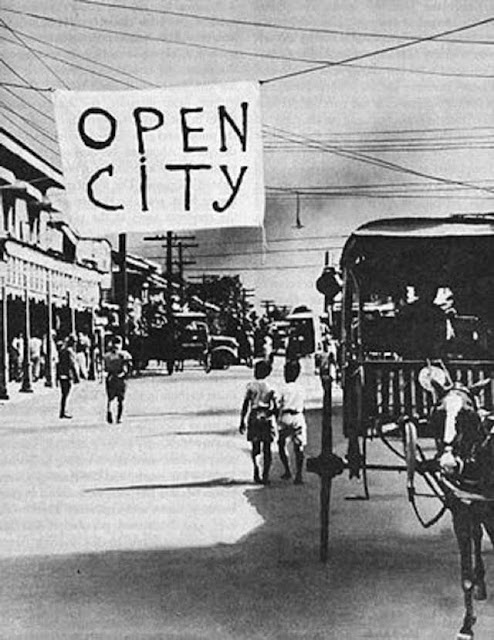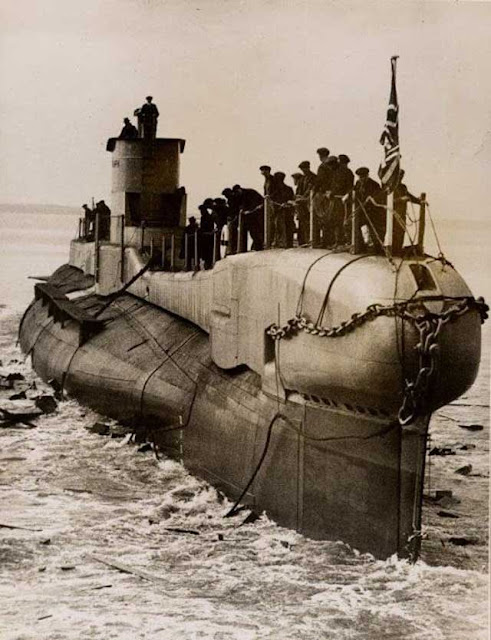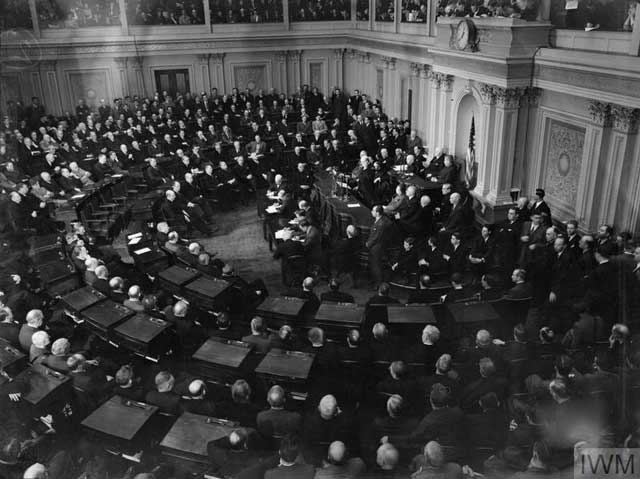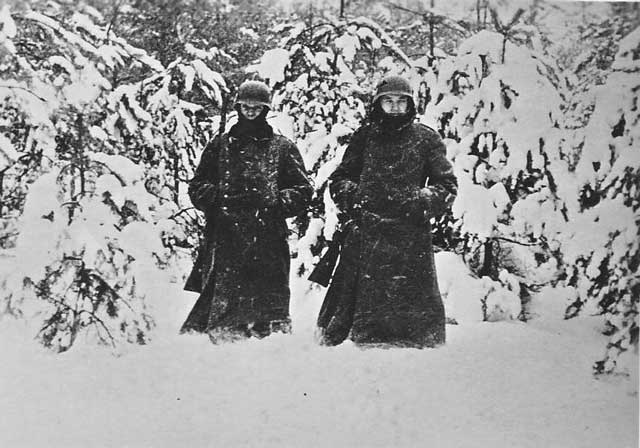Friday 26 December 1941
 |
| Manila, Philippines is declared an open city 26 Dec 1941 (US Army Center of Military History). |
Eastern Front: Soviet troops from the Taman Peninsula land near Kerch on the Crimea early on
26 December 1941. The landings are difficult, both because of the weather conditions and local defenders. The 224th Rifle Division and 83rd Naval Infantry Brigade successfully land at Cape Khroni to the northeast of Kerch. Another battalion follows later in the day, bringing T-26 tanks and light artillery. Other landings are less successful, with an attempted 302nd Mountain Rifle Division landing at Kamysh Burun south of Kersh prevented by Wehrmacht troops of the 42nd Infantry Regiment (Colonel Ernst Maisel) firing down at them from high ground. In addition, an attempted landing at Etigen is wiped out by the German 2nd Battalion of the 42nd Infantry Regiment. Two successive landings at Stary Karantin are smashed by the German 1st Battalion (Major Karl Kraft) of the 42nd Infantry Division, but enough men get ashore to seize the docks at Kamysh Burun and establish a bridgehead.
The Red Army troops have all sorts of difficulties, with some drowning, some of their whaleboats capsizing, and men freezing to death of hypothermia. However, there are no German troops nearby, so they manage to build a bridgehead. The Luftwaffe begins counter-attacking around 10:50 with He-111 medium bombers and Ju-87 Stuka dive bombers, and they sink Soviet transport Voroshilov at Cape Tarhan and another ship off Cape Zyuk. About 450 men perish in the Voroshilov and 100 on the other ship. The Luftwaffe also sinks several Soviet ships off Kamysh Burun, enabling only 2175 out of 5200 Soviet troops to get ashore there.
 |
| Soviet troops retaking Naro-Fominsk southwest of Moscow ca. 26 December 1941. |
Army Corps commander Lieutenant General Sponeck, in control in the Kerch Peninsula while General Erich von Manstein focuses the bulk of the 11th Army further west at Sevastopol, spends the day trying to figure out the Soviet objectives from the confused reports from the front. The German intelligence services extract information from a captured Soviet officer at Cape Khroni suggesting that the plan is to land 25,000 troops at Kerch. Lieutenant General Kurt Himer quickly orders troops east from the port of Feodosiya on the southern coast - leaving that port undefended. By the end of the day, the Germans feel they have enough troops in a position to launch a counterattack against the northern landings and eliminate them while holding in the south. However, the German forces are a hodgepodge of infantry, artillery, and combat engineers who are being assigned tasks for which they are not prepared. The counterattack is scheduled for around midday on the 27th.
 |
| Seaplane tender USS Tangier, which lands US Marines of the 4th Defense Battalion and their guns and equipment on Midway Island on 26 December 1941. Tangier had been sent to do the same at Wake Island, but the Japanese conquered Wake before Tangier could get there, so it was diverted. Included in this shipment are a 5-inch gun, twelve anti-aircraft machine guns, and radar equipment. |
Battle of the Pacific: Mandatory evacuations of civilians from Hawaii begin on 26 December 1941. The first convoy load to the port of San Francisco is carried aboard the three Matson Liners (Lurline, Matsonia, and Monterey). The loading is frantic and the captain of the Lurline does not even know how many people are aboard until a count is made en route. Everybody is tense because there have been Japanese submarine attacks off the west coast and nobody knows where the Japanese fleet has gone since the attack on Pearl Harbor.
 |
| Operation Anklet, a British Commando raid on the Lofoten Islands, takes place on 26 December 1941. It is undertaken by 300 men of No. 12 Commando assisted by Norwegian Independent Company 1. The landings are supported by 22 ships and begin at 06:00. There is no German opposition when the Commandos arrive on the island of Moskenesøya, and the Commandos capture a small German garrison and some Norwegian Quislings at the radio station at Glåpen. The Commandos occupy the island for two days. |
In the Philippines, Lieutenant General Douglas MacArthur declares Manila an open city. The U.S. evacuation into the Bataan Peninsula is almost complete. The South Luzon Defense Force sets up a defensive line west of Sariaya. The Japanese send Nell and Betty bombers from Formosa to bomb shipping in Manila Bay, scoring a near miss on destroyer USS Peary. Rear Admiral Francis W. Rockwell, Commander of the Sixteenth Naval District and the Philippine Naval Coastal Frontier, establishes his headquarters on Corregidor Island while his troops burn patrol boat PT-33, which has been damaged by grounding.
 |
| U-559 torpedoes and sinks Polish 2487-ton Warszawa (shown) off Mersa Matruh, Egypt on 26 December 1941. There are 24 deaths and 453 survivors (mostly troops from Tobruk). The sinking is slightly unusual in that Warszawa is taken in tow after the first torpedo strike, but U-559 sees this and then pumps a second torpedo into it, sinking Warszawa. |
On the Malay Peninsula, the Commonwealth troops continue retreating south toward Singapore. While the Indian 12th Brigade Group delays the advancing Japanese at Chemor, the 11th Indian Division slips out of Ipoh just to the south. In London, Whitehall is aware of the deterioration of the British position and notifies General Claude Auchinleck, Commander-in-Chief Middle East Command, that it transferring four RAF fighter squadrons from the Middle East to the Far East - showing that the Japanese attack at least indirectly is helping the Germans in North Africa.
 |
| "USS Tangier (AV-8) (R) unloads supplies at Midway, 26 December 1941; USS RALPH TALBOT (DD-390) and USS BLUE (DD-387) are at left; TAMAHA (YN-440) is in the background, center. TANGIER had originally been earmarked for the Wake Island relief expedition." Naval History and Heritage Command. |
On Borneo, the Japanese consolidate their position at Kuching. Dutch B-10s operating out of Samarinda attack Japanese shipping and sink a collier and a minesweeper. On land, the 2nd Battalion, 15th Punjab Regiment continues retreating into the interior.
 |
| HMS Triumph (Lt. John Symons Huddart, RN). After sailing from Alexandria on 26 December 1941, Triumph lands a party on Antiparos Island and then goes on a patrol in the Aegean from which it does not return. It is surmised that Triumph hit an Italian mine and sank off Cape Sounion, Greece. |
The Tulsa Incident continues in Rangoon. US Army Air Force Major General George Brett, the senior United States officer in Burma, has control over all Lend-Lease affairs, though the War Department intends that more for negotiating purposes than for actual control over the material goods. With the Japanese advancing into Burma, Brett is determined to divert Lend-Lease supplies from their intended destination in China to the British. He is abetted in this by British determination to seize the supplies, and Governor Reginald Dorman-Smith considers the military situation to be grave enough to seize them. U.S. Lieutenant Colonel Joseph J. Twitty, who actually is in charge of the Lend-Lease goods, also believes that the British need the supplies and that they cannot make it to China anyway. The British troops in Rangoon have moved all of the freighter Tulsa's cargo to a warehouse a dozen miles away from the docks even though technically they are "owned" by the Chinese. The Chinese are furious. The situation now has dragged on for over a week now and poses a growing threat to Allied relations. A Christmas day conference between representatives of the three governments turned explosive, with Chinese Generalissimo Chiang Kai-shek threatening to withdraw all Chinese troops from Burma. Today, the Americans reassure Chiang Kai-shek that it is not the policy of the Americans to divert Lend-Lease goods while en route and they still are intended for China. This smooths things over for the moment, but the British remain committed to retaining the cargo.
 |
| Winston Churchill addresses a joint session of Congress in Washington, D.C., on 26 December 1941 © IWM (A 7187). |
Anglo/US Relations: British Prime Minister Winston Churchill, in Washington for the Arcadia Conference, addresses a joint session of the U.S. Congress. He warns that "many disappointments and unpleasant surprises await us" and that the war will last at least another 18 months.
 |
| Robertson Stadium under construction in Houston on the campus of the University of Houston, 26 December 1941 (Photography by Elwood Payne, Construction by Fretz Construction Company). |
American Homefront: Lieutenant General John DeWitt, Commanding General Fourth Army and Commanding General Western Defense Command, is encountering widespread sentiment in southern California to intern all Japanese-Americans. He tells the Provost General in Washington, D.C. that the Los Angeles Chamber of Commerce now supports the move. However, DeWitt personally is against the move because he considers many citizens of Japanese descent to be loyal Americans.
 |
| Winston Churchill addressing Congress, 26 December 1941. |
December 1941
December 1, 1941: Hitler Fires von Rundstedt
December 2, 1941: Climb Mount Niitaka
December 3, 1941: Hints of Trouble in the Pacific
December 4, 1941: Soviets Plan Counteroffensive
December 5, 1941: Soviets Counterattack at Kalinin
December 6, 1941: Soviet Counterattack at Moscow Broadens
December 7, 1941: Japan Attacks Pearl Harbor
December 8, 1941: US Enters World War II
December 9, 1941: German Retreat At Moscow
December 10, 1941: HMS Prince of Wales and Repulse Sunk
December 11, 1941: Hitler Declares War on US
December 12, 1941: Japanese in Burma
December 13, 1941: Battle of Cape Bon
December 14, 1941: Hitler Forbids Withdrawals
December 15, 1941: The Liepaja Massacre
December 16, 1941: Japan Invades Borneo
December 17, 1941: US Military Shakeup
December 18, 1941: Hitler Lays Down the Law
December 19, 1941: Brauchitsch Goes Home
December 20, 1941: Flying Tigers in Action
December 21, 1941: The Bogdanovka Massacre
December 22, 1941: Major Japanese Landings North of Manila
December 23, 1941: Wake Island Falls to Japan
December 24, 1941: Atrocities in Hong Kong
December 25, 1941: Japan Takes Hong Kong
December 26, 1941: Soviets Land in the Crimea
December 27, 1941: Commandos Raid Norway
December 28, 1941: Operation Anthropoid Begins
December 29, 1941: Soviet Landings at Feodosia
December 30, 1941: Race for Bataan
December 31, 1941: Nimitz in Charge
2020











No comments:
Post a Comment